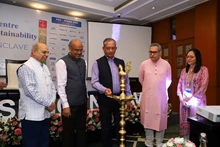
Black thrips (Thrips parvispinus), a highly polyphagous pest has become a major insect pest in recent days for chili and capsicum crops in India. It is an invasive insect species from Indonesia and was first reported in 2015 on a papaya plantation in Bengaluru, Karnataka.
It has also been reported on infesting beans, eggplant, papaya, pepper, potato, shallot and strawberry. In Telangana, Andhra Pradesh it was found infesting sweet pepper, brinjal, black gram, pigeon pea, watermelon, cucumber, bottle gourd, mango, and cotton, and others in Telangana, Andhra Pradesh. The establishment of this thrips species warrants special attention in India as it is a potentially damaging plant pest and has a wide host range across various plant families.
The pest is also widely distributed across the states viz., Andhra Pradesh, Assam, Chhattisgarh, Gujarat, Karnataka, Kerala, Maharashtra, Odisha and Tamil Nadu within 7 years. The insect species is affecting the plants at the flowering stage and stunting the growth of fruits. Females of T. parvispinus are brownish to black with yellow legs; forewing brown with pale base and they lay cylindrical to kidney-shaped eggs on or into leaves, buds, or other locations where larvae feed.
Thrips hatch from an egg and develop through two actively feeding larval stages and two nonfeeding stages, the prepupa, and pupa, before becoming an adult. Larva sucks the sap of leaf, flower and also the fruit, causing extensive damage to the crop within no time.
Thrips feeding on plants can even damage fruit, leaves, and shoots and very noticeably affect plants cosmetic appearance. Thrips feeding can stunt plant growth and cause damaged leaves to become papery and distorted, develop tiny pale spots (stippling), and drop prematurely. Infested terminals may discolor and become rolled. Scientists are advising farmers to implement integrated pest management practices like spraying neem oil and using bio-pesticides as an immediate remedy.
Also, constant monitoring, use of pongamia oil, or soap solution in heavily infested sites, and judicious use of chemical insecticides as well as fertilisers is recommended.











